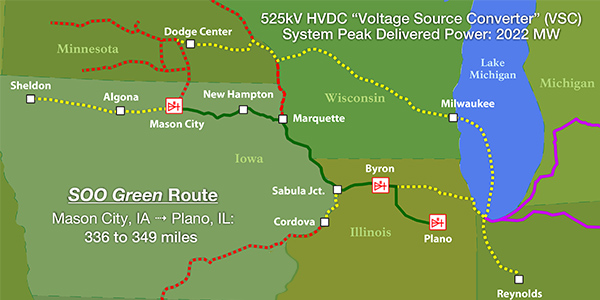By Steve Huntoon

Please accept instead this diatribe on something only a little less preposterous – a newly announced HVDC transmission line from Mason City in northern Iowa to the ComEd zone in northern Illinois.2
Yes, just after I declared Big Transmission still dead last month,3 along comes this 349-mile, 2,100-MW line that would be built underground in an existing railroad corridor at an estimated cost of $2.5 billion.
The business case is based on bringing wind generation from MISO to PJM. “We’re going to beat all of PJM with cheap renewable power prices,” according to the president of the independent development company proposing the merchant project.4
OK, where do we start? Well, let’s see. Last year, the average real-time LMP at the Minnesota Hub in MISO was $26.76/MWh.5 The average real-time LMP for the ComEd zone in PJM was $28.59/MWh.6 The difference is $1.83/MWh. We’ll come back to that number.
The all-in (pre-tax) cost of capital is estimated by Brattle/PJM for a new merchant generation project at 10%.7 Let’s use that cost of capital as a proxy for a merchant transmission project like this one.
A $2.5 billion capital cost times 10% is $250 million per year. Add annual depreciation of $50 million for a 50-year life. Generously assume transmission losses, O&M and management costs are zero. Divide the $300 million (annual cost of capital plus depreciation) by 2,100 MW times 8,760 hours in the year times a generous 50% capacity factor (9,198,000). You get $32.62/MWh.
So here’s the rub. There’s a $1.83/MWh difference between MISO and PJM LMPs, but the project needs an additional $30.79/MWh ($32.62/MWh minus $1.83/MWh) in order to be viable.
Why? Because no sane wind developer is going to commit to a long-term contract to pay this project $32.62/MWh for transmission service to ComEd/PJM when it can only make an additional $1.83/MWh relative to what it can get for its wind generation in MISO.
And that’s just the beginning of the rub. We haven’t included the costs of the “collector systems” to get 2,100 MW from wind projects scattered across Minnesota, Iowa, etc. to an HVDC converter station in Mason City, Iowa. We haven’t included the costs of upgrading ComEd/PJM transmission lines in northern Illinois to absorb the 2,100 MW to be delivered by converter stations at Byron, Ill., and Plano, Ill.
Oh, and on this last item we know the costs would be staggering because PJM did feasibility studies for 2,000-MW merchant transmission projects at Byron and Plano sinks in 2016. Many 345-kV lines would be overloaded and need to be upgraded.8 Not cheap. The project might elect not to upgrade the overloaded lines and take its chances on what would flow on an “energy-only” basis, but think about how the bottled-up energy at the converter stations would crater LMPs at those sinks. Yikes.
Big Transmission, like Generalissimo Francisco Franco, is still dead.
1-My prior take on some of that in the context of the Jacobson-Clack debate can be found here: http://energy-counsel.com/docs/Alternative-Facts-and-Global-Warming.pdf
3-http://energy-counsel.com/docs/The-Test-of-Time.pdf
4-Utility Dive is playing its usual role of gee whiz cheerleader: https://www.utilitydive.com/news/independent-developer-proposes-25b-underground-transmission-line-adding/550399/
5-Averages for the months, and the peak and off-peak periods, in the MISO monthly reports can be found here: https://www.misoenergy.org/markets-and-operations/#nt=%2Fmarketsandopstype%3AMarket%20Analysis%2Fmarketanalysistype%3AMonthly%20Market%20Operations%20Reports&t=10&p=0&s=FileName&sd=desc
6-http://www.monitoringanalytics.com/reports/PJM_State_of_the_Market/2018/2018-som-pjm-sec3.pdf (page 81)
7-https://elibrary.ferc.gov/idmws/common/opennat.asp?fileID=15069666 (page 200, “Effective Charge Rate”)
8-https://www.pjm.com/pub/planning/project-queues/merch-feas_docs/ab1121_fea.pdf; https://www.pjm.com/pub/planning/project-queues/merch-feas_docs/aa2108_fea.pdf




